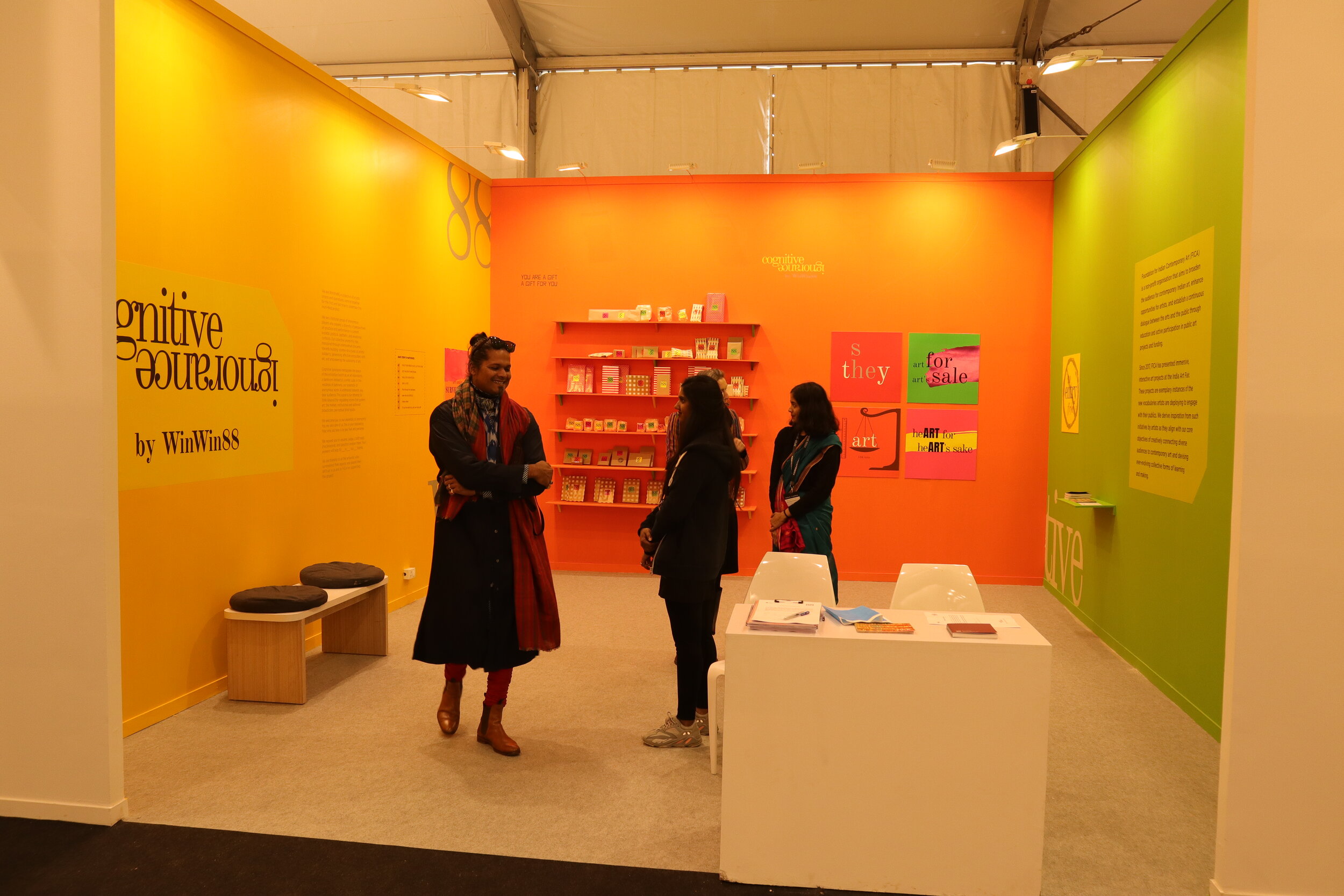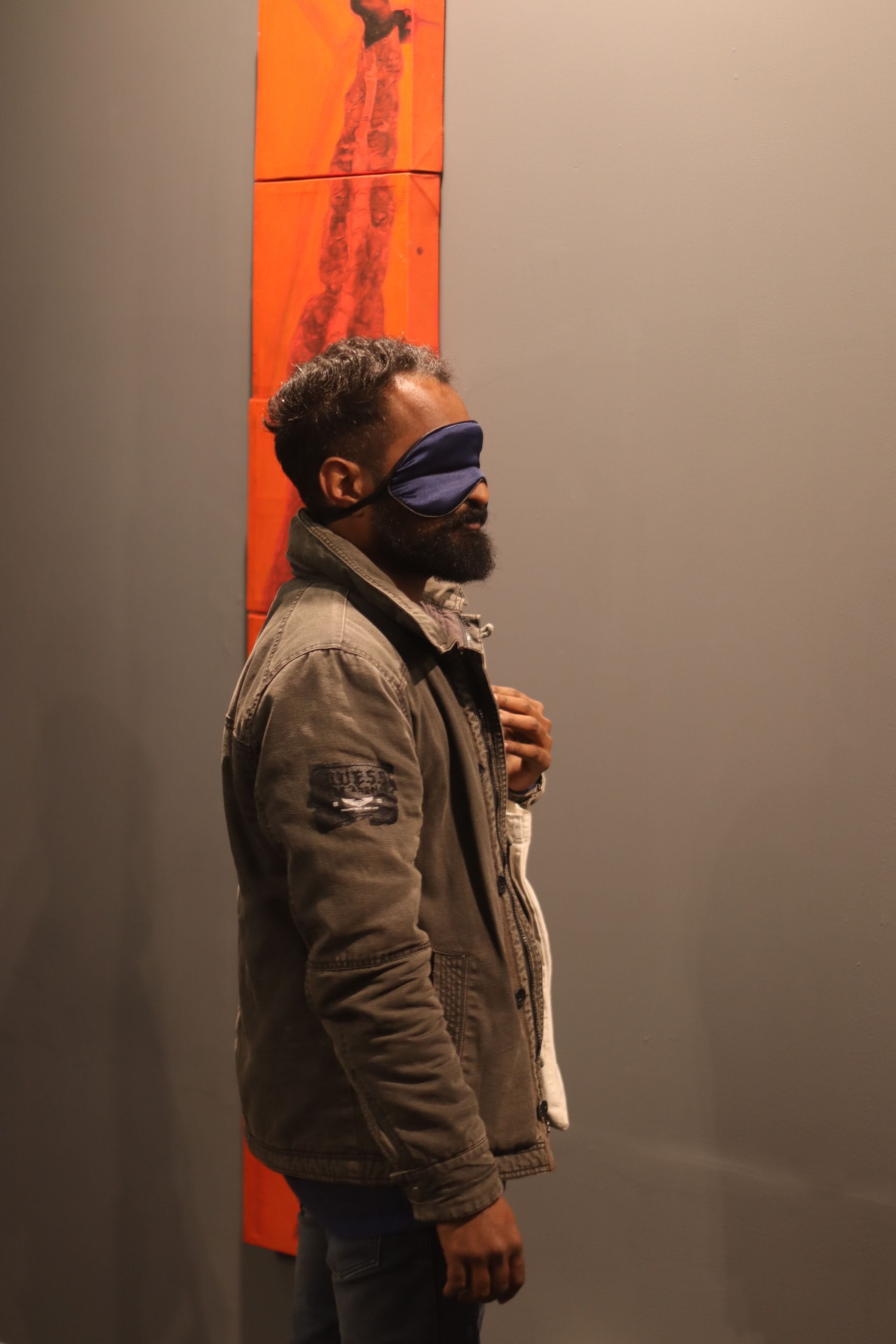We announced our presence at India Art Fair 2020 with a special project titled Cognitive Ignorance. The project entailed the coming together of an anonymous ensemble of players and artworks, represented by a fictional collective WinWin88.
Like our projects in previous years, Cognitive Ignorance, sought active audience participation. The anonymity of the Collective - and of the artworks - was aimed at generating affective encounters with art, augmenting the works in themselves, outside of instructional aids and identifiers that might influence viewership and reception.
Imagining the space of the exhibit as an art-laboratory, Cognitive Ignorance created and elicited a re-contextualisation - of systems of perception, information, and agency - within larger discourses around the art market, notions of value, worth and meaning. By doing so, WinWin88 sought to question and challenge accepted notions of authorship, gender, nationality, language, familiarity, and context that facilitate a viewer’s experience of an artwork. However, the gamified vacuum created by the absence of wall-texts, captions, and artist names urged audiences to stay with their instincts and participate in forming their own environments of affect and understanding.
Viewers were encouraged to mine an experience of their own, working through their immediate responses to the space(s) and sensations they encountered. They were invited to actively interact with the works on display, reading and responding to prompts and questions placed instead of informational wall-texts that usually accompany artworks in an exhibition space.
Evoking counter-structures of artistic solidarity, WinWin88 conceived of Cognitive Ignorance as an exercise in intellectual humility, inviting both personal and structural relationships to form with the artworks. The project was aimed at activating the space of the exhibition through the medium of response - whether hesitant, instinctual, dismissive, cognitive or inspired.
Straight down the hall from D06 was our main exhibition booth, D09. It was curtained away from the rest of the Fair, creating a sense of mystery around the exhibition, as well as defining a space separate from visual, audio, and other sensory stimuli, that could distract or influence the audience. Led through the curtains, one would be met with an inner ante-chamber where the viewer would be met with flashes of light. Another set of black curtains, and finally, the exhibition booth.
The project spanned two booths (D06 and D09) at the India Art Fair, where the brightly coloured D06 functioned primarily as an informational and introductory booth for viewers. It played a role in setting the tone for our exhibition booth at D09. It facilitated a breaking up and slowing down of the process of viewership, leading the viewer away from intense informational and visual instigation to the lack of colour and context within the larger booth.
Conditions Apply!
There were multiple entry points provided throughout the exhibition for viewers to intervene and interact with the artworks. Viewers were encouraged to use accessories called ‘Exhibition Filters,’ which was a selection of items such as sunglasses, stress balls, yoga mats, incense cones, and other small sensory tools that could add another layer to their perception of the space. The walls of the inside were coloured dark grey to remove the sense of starkness usually associated with exhibition spaces. Instead of choosing to provide visitors with detailed wall-texts, thought-provoking questions were placed alongside the artworks, inviting the viewer to introspect.
These served as prompts for the viewers, encouraging them to think about how artworks could be viewed, while also asking for specific sets of responses that the viewer could provide using colourful stickers, sticky-notes, notebooks and note cards that were made available. A ballot box was placed at the exit station of the exhibition for viewers to submit response postcards that invited the viewer to think about what they were “taking away” and what they were “leaving behind”. Upon submitting a response, viewers stood a chance to win a gift! Here, answers ranged from somber (memories, thoughts, emotions), to funny (a pen drive, a sticker, someone even wrote that they left their boyfriend behind). This activity allowed the viewer to encounter their own positions of anonymity within the framework.
Disrupting, Intervening, Performing
There were also hourly performative interventions choreographed by our volunteer-performer-players, who took on a heightened role speaking with the audience, while also activating the exhibition space. They played a key role in being present in the space, encouraging reflections from viewers, performing the role of cryptic advisors, tabulating responses, and also intervening when they felt required, to assist viewers in formulating their responses - intellectual, affective, and otherwise. The volunteers had many interesting interactions with viewers, in terms of conversations and observing the choices they made within the Booth. The performative interventions took on a disruptive role confusing and fascinating viewers, which would stop as abruptly as they would start, occupying the exhibition space at large.
Due to the participatory nature of the project, people felt involved in the exhibition as a whole. Between the two booths, one being registration and the second being the main exhibition booth, viewers were introduced to the exhibition format, being made aware of the fact that they were being surveilled through the form which they had to sign consenting to this. As the project addressed themes on and around gender, nationality, language, and the possibilities of art itself, it was fascinating to watch the ways in which people chose to engage with the prompts. They took the time to find the right words to articulate their opinions and thoughts, sometimes even introspecting about how deeply conditioned people are in exhibition spaces. The stark contrast between friendly colours and grey and black backgrounds allowed viewers to receive the space with curiosity to participate and as certain invitation.
Afterlives
Following the exhibition at the India Art Fair 2020, Cognitive Ignorance entered into its second phase - assimilating, reflecting, collating, regarding, considering, and conversing with new possibilities, routes and rethinkings.
As an afterlife to the exhibition, extending its possibilities, we launched Cognitive Ignorance: The Publication in 2022.



























